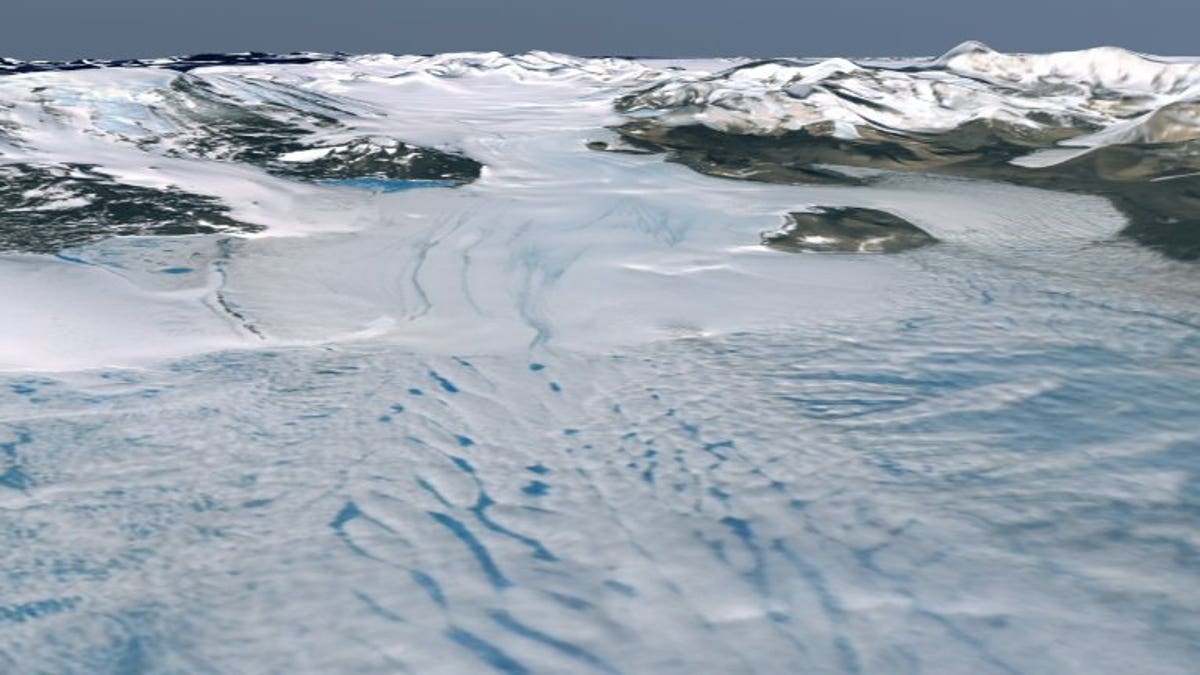
A satellite image of the Koettlitz Glacer in Antarctica. (NASA/Goddard Space Flight Center Scientific Visualization Studio)
The world's most famous climate change expert is at the center of a massive controversy as the leading environmental science institute he heads scrambled to explain its assertion that the Himalayan glaciers will melt completely in 25 years.
Rajendra Pachauri, head of the U.N.'s Intergovernmental Panel on Climate Change (IPCC) and director general of the Energy and Resources Institute (TERI) in New Dehli, India, said this week that the U.N. body was studying how its 2007 report to the United Nations derived information that led to its famous conclusion: that the glaciers will melt by 2035.
Today, the IPCC issued a statement offering regret for the poorly vetted statements. "The Chair, Vice-Chairs, and Co-chairs of the IPCC regret the poor application of well-established IPCC procedures," the statement says, though it goes short of issuing a full retraction or reprinting the report.
Pachauri told Reuters on Monday that the group was looking into the issue, and planned to "take a position on it in the next two or three days."
The IPCC's 2007 report, simply titled AR4, claimed that "glaciers in the Himalayas are receding faster than in any other part of the world, and if the present rate continues, the likelihood of them disappearing by the year 2035 and perhaps sooner is very high if the Earth keeps warming at the current rate."
Contacted by FoxNews.com at TERI, officials would not respond to a request for additional comment. IPCC is expected to withdraw the report's claim eventually.
Hundreds of millions of people in India, Pakistan and China would be severely affected if the glaciers were actually to melt. There are some 9,500 Himalayan glaciers.
Indian Environment Minister Jairam Ramesh questioned the findings of the 2007 report during a news conference.
"They are indeed receding and the rate is cause for great concern," Ramesh said of the glaciers. But, he said, the IPCC's 2035 forecast was "not based on an iota of scientific evidence."
One of the key elements in the growing scandal is the revelation that IPCC based some of its public proclamations on non-peer reviewed reports.
"The data, all the data, needs to come to light," says Dr. Jane M. Orient, president of Doctors for Disaster Preparedness and an outspoken skeptic on climate change.
"Thousands of scientists are capable of assessing it. The only reason to keep it hidden, locked in the clutches of the elite few, is that it decisively disproves their computer models and shows that their draconian emission controls are based on nothing except a lust for power, control and profit."
The IPCC "made a clear and obvious error when it stated that Himalayan glaciers would be gone by 2035," added Patrick J. Michaels, a senior fellow in environmental policy at the libertarian Cato Institute, in an interview.
"The absurdity was obvious to anyone who had studied the scientific literature. This was not an honest mistake. IPCC had been warned about it for a year by many scientists."
A letter just released to the Science Web site underscores the mistake. Written by J. Graham Cogley of the department of geography at Canada's Trent University, it points out that "the claim that Himalayan glaciers may disappear by 2035 ... conflicts with knowledge of glacier-climate relationships, and is wrong."
The dustup is the latest scandal in global warming science, coming after the disclosure of attempts to shade climate-science research findings at the U.K.'s East Anglia University and the failed talks in Copenhagen by environmental policymakers last month.
The IPCC report had indicated that the total area of Himalayan glaciers would shrink from 500,000 square kilometers to 100,000 square kilometers within 25 years. The study cited a 2005 report by the World Wildlife Fund, an environmental advocacy group. The WWF study cited a 1999 article in New Scientist magazine that quoted another expert, who speculated that Himalayan glaciers could disappear within forty years.
The speculative comments were not peer reviewed, and other reports have indicated that the glaciers are not retreating abnormally.
"Most Himalayan glaciers are hundreds of feet thick and could not melt fast enough to vanish by 2035. The maximum rate of decline in thickness seen in glaciers at the moment is two to three feet per year, and most are far lower," Don Easterbrook, a professor emeritus of the department of geology at Western Washington University, told FoxNews.com.
Pachauri, the IPCC chief, is under attack on another front, as well, as newspaper reports in India have commented repeatedly on his reportedly lavish lifestyle. TERI receives funding from the U.S. Environmental Protection Agency and the U.S. Department of Energy, both of which did not respond to requests for comment from FoxNews.com. Reports indicate that there also are concerns in the United Kingdom surrounding 10 million British pounds in funding for TERI, and questions about TERI's objectivity.
"It's about time that somebody started following the money trail to the big interests that want to prosper from the green regime, while the rest of the economy is crushed," Orient told FoxNews.com. "It's not as though the amount were a trickle."
